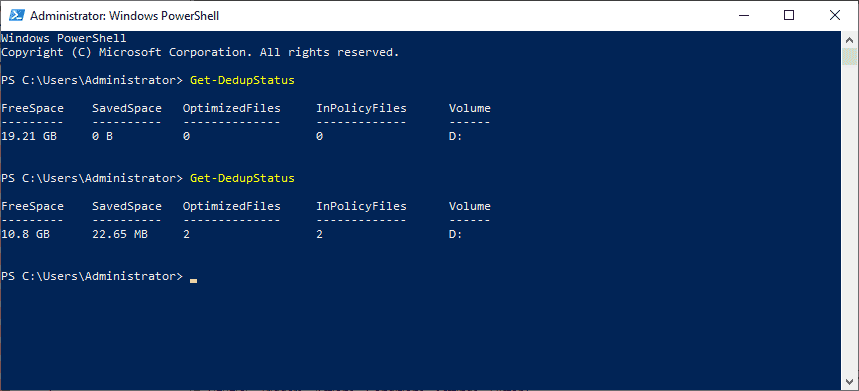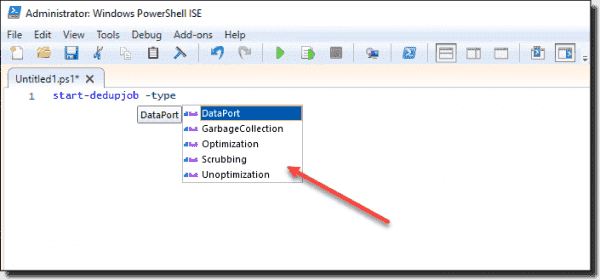What Powershell Cmdlet Will Allow You to Review the Status of a Running Deduplication Job?
Storage technologies take certainly evolved over the past several years and provide many powerful tools to allow the most efficient apply of provisioned space. Ane of the technologies available in Windows Server is deduplication. Microsoft continues to add new capabilities to the deduplication feature with each Windows release.
- Author
- Contempo Posts
![]()
What benefits are provided by Windows Server deduplication? How is the feature added? How exercise y'all enable deduplication, cheque its status, and pause or stop the deduplication procedure? Permit's take a look at Windows Server deduplication.
What is information deduplication in Windows Server? ^
When you store data comprising various files and other information on any Windows Server, there volition be duplicated data blocks among the multiple files. It is especially true if the different files stored on a Windows Server volume are similar in content or structure. A departmental file server is a skillful instance that helps visualize how there may be vast amounts of duplicated data. In a large file share, end users may shop many copies of the aforementioned or like files. This leads to redundant copies of data that impact the efficiency of storage.
Instead of storing multiple copies of data, as in traditional storage environments, deduplication provides the means to store the data once and create intelligent pointers to the actual information location. In this way, the storage environment does not house duplicated information. Microsoft keeps improving the features of deduplication as well. In Windows Server 2019, Data Deduplication tin now deduplicate both NTFS and ReFS volumes. Prior to Windows Server 2019, ReFS deduplication was not possible.
How does Windows Server information deduplication work? ^
Microsoft uses two principles to implement data deduplication in Windows Server:
- The deduplication process runs on data by using a post-processing model . This ways that the deduplication process does not interfere with the performance of the write process. When data is written to the storage, information technology is not optimized. Afterward, the deduplication optimization process runs to ensure the deduplication of the data.
- End users are unaware of the deduplication process—Deduplication in Windows Server is entirely transparent. End users are unaware they may exist working with deduplicated data.
To achieve the successful deduplication of data in accordance with the principles listed higher up, Windows Server uses the following procedure:
- The file arrangement scans storage to notice files matching the deduplication optimization policy.
- The system breaks the files into chunks.
- Unique chunks of file information are identified.
- These file chunks are placed in the clamper store.
- Pointers to the clamper store are created to let redirecting file reads to the advisable file chunks.
Strong use cases for data deduplication
Specific use cases lend themselves favorable to data deduplication. What are workloads that typically prove massive benefits to using information deduplication? Let's listing these in the order of the nigh pregnant benefits.
- 80–95% space savings—Virtualization environments, peculiarly VDI workloads and ISOs for deployment.
- lxx–80% space savings—Deployment shares incorporate massively duplicated data stores of software binaries, cab files, and other operation-specific files.
- 50–60% infinite savings—General file shares tin can contain monolithic repositories of files that tin can include a tremendous corporeality of duplicated data.
- xxx–50% space savings—User documents can contain standard user files that may include photos, music, and videos.
Installing the Windows Server Dedup ^
The process to install the Windows Server Dedup characteristic is straightforward. Administrators can install Dedup using the GUI Server Manager, Windows Admin Center, or PowerShell. Data Deduplication is function of the File and Storage Services office in Windows Server. Below is a screenshot from Windows Server 2019.

Installing the Data Deduplication File and Storage Services office in Windows Server 2019
Using PowerShell, you can enable data deduplication using the following cmdlet:
Install-WindowsFeature -Name FS-Data-Deduplication
Information Deduplication installation in Windows Admin Eye is carried out by visiting the Roles and Features carte du jour and placing a check next to Data Deduplication, which is establish under the File and Storage Services part.

Using Windows Admin Heart to install Data Deduplication in Windows Server 2019
Enabling Information Deduplication on a Windows Server volume ^
Once you take installed Data Deduplication, the process to enable it on a volume is straightforward. Using Server Manager, navigate to File and Storage Services > Volumes > Disks. Click the disk. Then click the book that resides on the disk that you want to deduplicate.

Enabling Data Deduplication for a Windows Server 2019 volume

Cull the type of files stored on the volume to be deduplicated
Under Deduplication Settings, you tin configure several options. These include:
- The age of the files to be deduplicated
- Custom file extensions to exclude
- Custom excluded folders
- Configuration of the deduplication schedule

Configuring Windows Server deduplication setting
The Deduplication Schedule configuration provides interesting options to customize the groundwork process used to run the data deduplication. You tin can farther customize the deduplication schedule and resource utilization using the throughput optimization options. Information technology also allows for multiple schedules.

Setting the deduplication schedule in Windows Server 2019
Running Data Deduplication Scheduled Tasks ^
You may wonder how the background tasks run. When you install Data Deduplication, Windows creates scheduled tasks to take intendance of the background process, garbage collection, and data scrubbing. If you desire to run these manually, you lot can. The background deduplication process runs by default every 1 hour indefinitely.

Windows Deduplication Scheduled Tasks in Windows Server 2019
Using PowerShell for condition and direction ^
PowerShell provides many great controls and options for interacting with Windows Server Data Deduplication. Let'due south take note of a few of these cmdlets. The Get-DedupStatus cmdlet displays the status of the deduplication operations and the deduplication percentage.
As y'all tin see, at offset, we have no space savings after Information Deduplication is installed and enabled. All the same, after the process begins to run, we start to see space savings on the book.

Getting the status of Information Deduplication for a storage volume in Windows Server
If yous want to disable and get rid of Data Deduplication, you tin practise this hands with a couple of PowerShell cmdlets:
Disable-DedupVolume -Volume <volume letter> Start-DedupJob -type Unoptimization -Book <volume letter>
What other types of DedupJobs tin can yous boot off from PowerShell?

Looking at the start dedupjob cmdlet blazon options in Windows Server 2019
Wrapping up ^
Windows Server Data Deduplication is a peachy style to repossess storage infinite efficiently in your Windows Server environment. With each Windows release, the deduplication capabilities go on to improve. It provides tremendous space-saving benefits with specific workloads, especially for general file servers and VDI virtualization environments. For virtualization environments, space savings can exist as much equally fourscore–95%.
Subscribe to 4sysops newsletter!
The Data Deduplication subcomponent of File and Storage Services is easy to add and enable on a specific storage volume. You can take advantage of many options to control the deduplication schedule, file types, and exclusions. PowerShell provides several cmdlets that let interacting with, managing, and controlling Windows Server Data Deduplication.
![]()
Source: https://4sysops.com/archives/windows-server-deduplication-how-it-works-how-to-install/
0 Response to "What Powershell Cmdlet Will Allow You to Review the Status of a Running Deduplication Job?"
Post a Comment